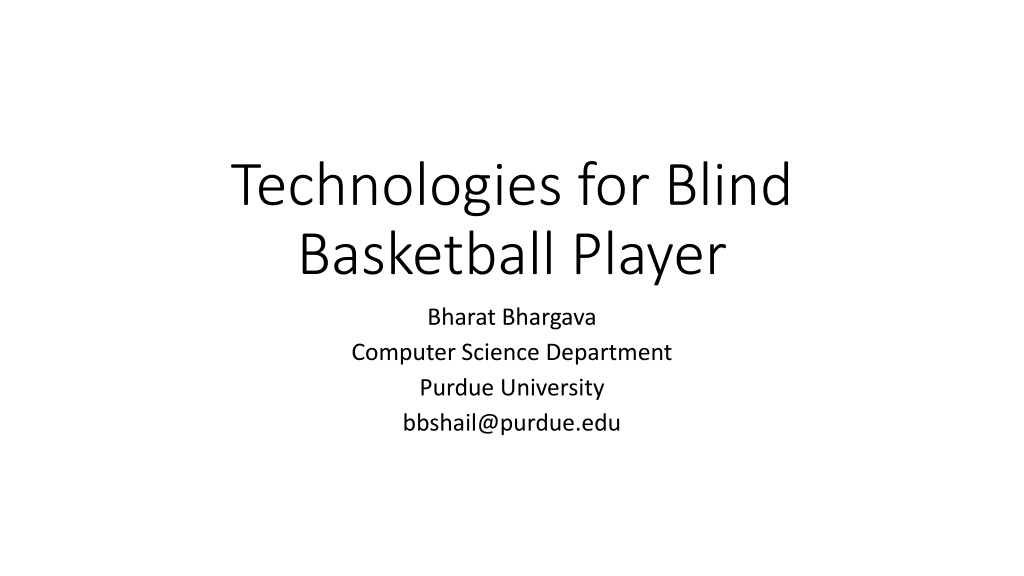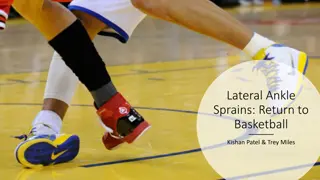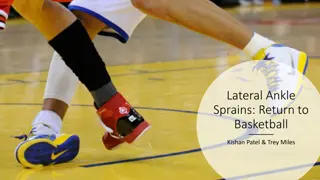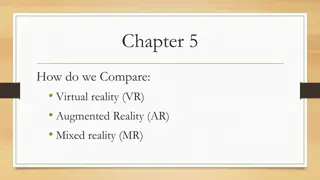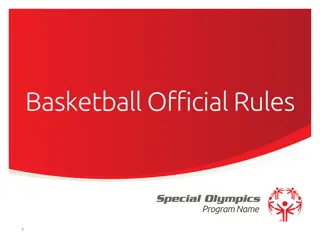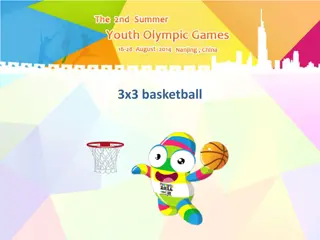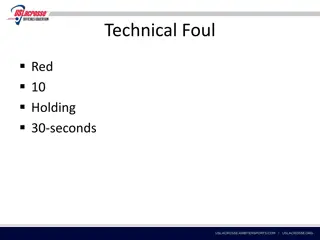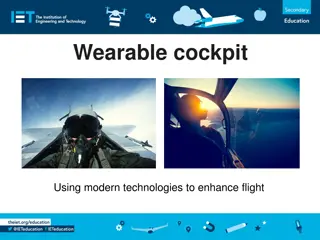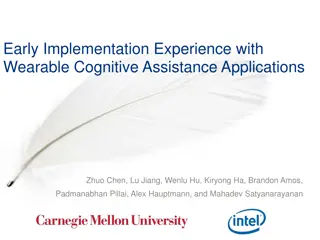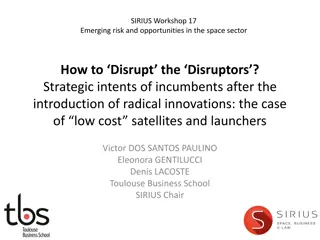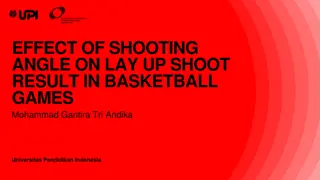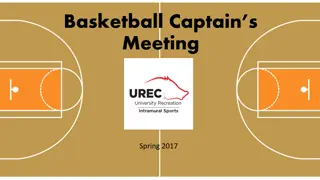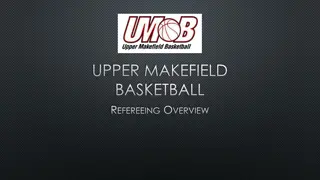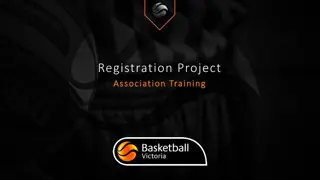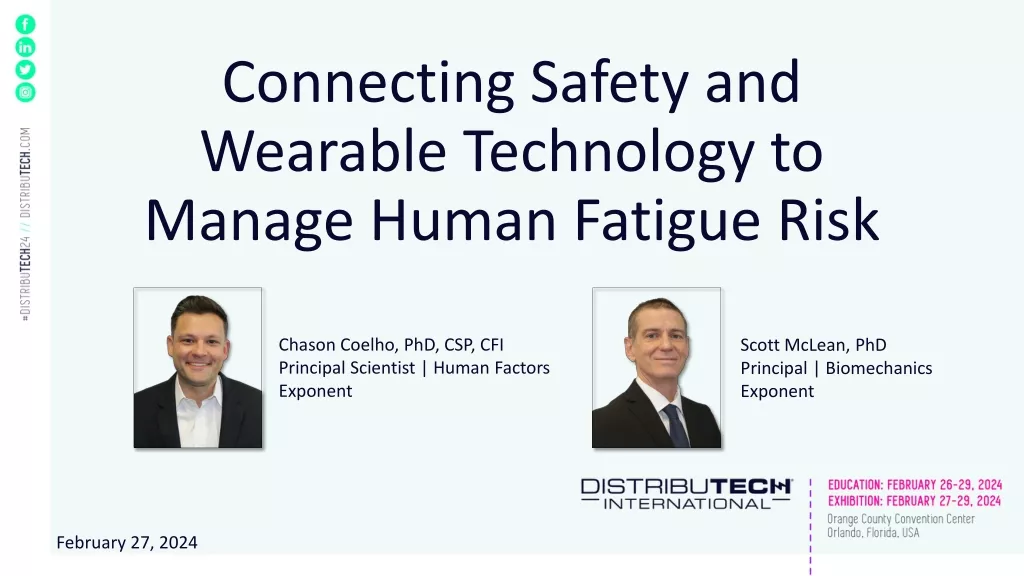Innovations in Wearable Technology for Blind Basketball Players
Wearable technology is advancing rapidly, with devices becoming smaller and more integrated into everyday wear like shoes, T-shirts, watches, and jewelry. Companies like GameTraka, Fitlinxx, Altruis, LG, and Neyya are blending technology with fashion to create innovative products. Examples include GPS devices, heart rate trackers, smart rings, and smart basketballs like the 94fifty, designed to enhance performance and monitoring capabilities for athletes. These advancements are transforming the way blind basketball players can interact with the sport and improve their skills.
Download Presentation

Please find below an Image/Link to download the presentation.
The content on the website is provided AS IS for your information and personal use only. It may not be sold, licensed, or shared on other websites without obtaining consent from the author. Download presentation by click this link. If you encounter any issues during the download, it is possible that the publisher has removed the file from their server.
E N D
Presentation Transcript
Technologies for Blind Basketball Player Bharat Bhargava Computer Science Department Purdue University bbshail@purdue.edu
Wearable Technology https://www.wearable-technologies.com/2015/10/the-best-wearable- devices-for-basketball/ https://www.wearable-technologies.com/2015/11/the-devices-that-are- making-wearable-tech-inviisible/ Wearable tech is becoming invisible, which means people are developing high tech devices that are smaller than ever before. These devices are bringing pervasive computing closer and closer to reality. This includes placing microprocessors into any object that can be worn on the body; such as inside of shoes, T-shirts, a classic watch and even jewelry. Technology is at the beginning of holding hands with fashion; however there are a few companies that have products on the market today.
Examples of Wearable Products GameTraka is defining the new shy tech, meaning that they integrate technology in a way that is blind to the eye. Their product is a GPS device that is placed behind the wearers neck like a kind of bra shape. GameTraka is aiming to fill a gap in the market for sport players. It is designed and developed for sub-elite athletes and amateur players. GameTraka allows to filter down to grass roots sport level and allow the wearer to track, measure and monitor physical performance. The Fitlinxx Ampstrip is a part of the emerging Smart Patches market. In February 2016 Fitlinxx will make Ampstrip publicly available. The Ampstrip is a heart rate and activity tracker that sticks comfortably to the wearers torso for around 7 days like a Band-Aid. Altruis is a connected ceramic stone that can be worn in a gold or silver plated ring, bracelet or necklace. Behind the look of a sparkling set of jewellery is a set of vibration controlled components. This digital jewellery which can vibrate to notice wearers of important message. The LG Urbane is the most stylish Android wear device because it combines the classic watch face design with a smart watch. It can navigate wearers and provide alerts at a simple glance. The Neyya Smart Ring stepped into the bling tech space in 2015. It is different from other smart devices on the market at the moment because it doesn t have a display screen, nor does it count steps. It doesn t even notify the wearer when there is a new message. It creates a remote control out of a piece of jewelry. For example, if you are at work you can use Neyya to navigate through a presentation, or even control a computer via Bluetooth. It also allows the wearer to control music, a camera and create a custom timer on a smart phone app via Bluetooth.
Some Displays smart ring
94fifty Smart Sensor Basketball 94fifty Smart Sensor Basketball
94fifty Basketball Infomotion Sports Technologies. The 94fifity is the official Smart Basketball of the National Association of Basketball Coaches. This regulation size, weight, spin and bounce basketball comes with a Qi wireless charger, and the mobile apps (iOS and Android) are free. It includes a custom- made bag to carry the ball in. Inside the ball are nine accelerometers and a gyroscope, sitting on a circuit board that weighs less than 20 grams. Those sensors can detect force (a 360-degree view of it) and speed, ball rotation and ball arc. The ball runs a lightweight operating system that dissects patterns in motion and can communicate anomalies in less than 100 milliseconds over Bluetooth. One can get instant feedback on every shot and dribble. The ball tracks four important metrics: dribble force/speed, shot speed, shot backspin and shot arc. It works in conjunction with an app that displays results on the fly. You can choose to work on various skills, or compete against other players through up to 34 different challenges. You will need to recharge this basketball. It will be good for 8 hours before needing a top-up.
Wilson X Connected Basketball Wilson X Connected Basketball
More Details on Basketball You can choose from one of two sizes: official (29.5 inches) or intermediate (28.5 inches). There are no wires, add-ons to attach to the hoop or wearables to strap on your wrist. Below the surface the ball contains a Bluetooth radio, low-power processor, and three- axis accelerometer, which with the help of some cleverly crafted algorithms track your baskets. Wilson says the algorithm is 98% accurate on makes and misses. Although you can use it in a game, the ball is designed to track a single player s shots. The ball can not tell when it has changed possession. This is why Wilson recommends to use the ball and app during solo training sessions only. The Wilson X syncs via Bluetooth to the smartphone app, which dishes out charts and graphs on your shooting statistics such as shooting percentages, shot attempts and total time in play. You donot need to charge the basketball. Its battery runs strong for over 100,000 shots that s 300 shots a day for a year. After that you can continue on using it as a regular ball, or perhaps trade it in.
Sensors in Jerseys/Clothing Sensors in Jerseys/Clothing http://engineering.tamu.edu/news/2015/02/11/grunlan-working- with-australian-rugby-team-to-develop-sensors-for-jerseys According to Grunlan, the sensors they are working to develop are polymer or plastic-based thermoelectric materials that can be applied as coatings to fabrics. When the body heats up when working out, as long as there is a temperature gradient, it can drive electricity, Grunlan said. That electricity could power sensors built into a jersey of an athlete and supply power to transmit information to a computer. It can tell about a person s hydration level or the G-force experienced from a hit.
JERSEY JERSEY- -EMBEDDED GPS AND THE TECH EMBEDDED GPS AND THE TECH- - CENTRIC FUTURE OF FOOTBALL CENTRIC FUTURE OF FOOTBALL http://www.catapultsports.com/media/jersey-embedded-gps-and-the-tech-centric-future-of- football. A live-tracking device that fits into undershirt during practice to pick up how one switches directions or slows down all important intelligence to help improve the future plays. Soccer stars use jersey-embedded GPS devices during matches to track how quickly they can deke someone out or monitor power output when they strike a ball. Equipping athletes with satellite technology is a relatively new concept. A decade ago, this corner of the sports-tech industry was tiny, with the entire market for wearable computing systems worth around $170 million in 2005, according to a study by the Venture Development Corporation. Gadgets for pro sports made up a slim portion of that, though they re expected to become a significant portion of the wearable industry, which has since ballooned to $20 billion and is projected to reach $70 billion by 2025. This helps sports teams gain an advantage however small over their opponents.
More Details continued Many of these GPS devices rest between players shoulders in a sleeveless bib or pocket and transmit live data about their location and speed. Embedded inertial sensors, with gizmos like gyroscopes, track a player s orientation, while magnetometers measure their direction. On top of this are heart-rate straps and accelerometers all of which deliver sports scientists fancy bio analytics to expose injury risks and pinpoint weaknesses in a specific play. For example, some sensors can show if a lineman blocks better to his right or whether a wide receiver should ease off before tearing a ligament. And while the who s who of this burgeoning industry are all names you d expect Nike, Adidas, Google, etc. the surprising leader of the pro wearable market is Catapult Sports, a small Australian company that, until recently, operated mostly anonymously. An Australian company managed to dominate the competition, with its sensors lining the uniforms of everyone from AC Milan soccer players to Spanish bullfighters?
Wearable and Compensating Disability But major league sports, especially those in the U.S., have not yet fully embraced sensors. The NBA and NFL, for instance, have yet to sanction them for in-game use. The use of wearables for specific applications, for compensating disabilities or supporting elderly people steadily increases. Wearable computers, also known as body-borne computers or wearables are miniature electronic devices that are worn under, with or on top of clothing. This class of wearable technology has been developed for general or special purpose information technologies. Wearable computer items have been developed and applied in the following Sensory integration, e.g. to help people see better or understand the world better (whether in task-specific applications like camera-based welding helmets]or for everyday use like computerized "digital eyeglass") Wearable computers are especially useful for applications that require more complex computational support, such as accelerometers or gyroscopes. http://internetofthingsagenda.techtarget.com/definition/wearable-computer Augmented memory, a concept originated by Thad Starner and being developed by Bradley Rhodes at the MIT Media Lab, in which as you enter a room, your wearable computer could sense the people present and remind you of their names or personal history, or a scheduler could whisper the time of an important meeting in your ear, or a "remembrance agent" could look for related documents by observing the words you were typing https://www.wearable-technologies.com/2015/10/the-best-wearable-devices-for-basketball/
